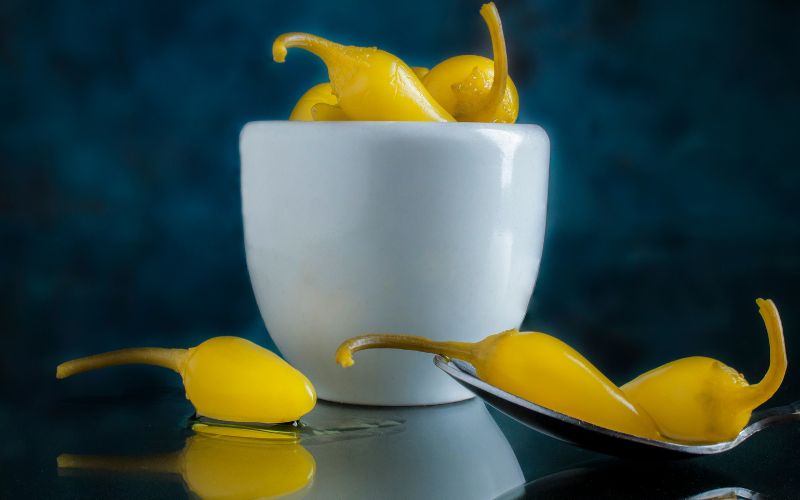If you’re looking for a delicious and unique pepper to grow in your garden, look no further than the Greek pepperoncini.
This variety of pepper is milder than most, with a slightly sweet flavor that makes it perfect for adding to salads, sandwiches, and other dishes.
Plus, they’re incredibly easy to grow.
When growing Greek pepperoncini peppers, it’s important to start with good-quality seeds. This will give you the best chance of success in germinating and growing strong, healthy plants. Once you have your seeds, sow them indoors about 8-10 weeks before the last frost date in your area.

Greek pepperoncini peppers are a type of Capsicum annuum, which is the species that includes most common varieties of peppers (like bell peppers and jalapeños).
They’re native to Greece and other parts of the Mediterranean, and have been grown there for centuries.
These days, you can find Greek pepperoncini seeds for sale online or at your local nursery.
How to grow Greek peppers
To sow the seeds, plant them in small pots or trays filled with a sterile potting mix.
Water the soil well and place the pots in a warm, sunny spot.
Keep the soil moist but not soggy, and within a few weeks you should see the seeds germinate.
Once the seedlings have a few sets of true leaves, they can be transplanted into larger pots or outdoors into the garden.
Pepperoncini plants need full sun and well-drained soil to thrive.
Amend the planting area with compost or other organic matter before transplanting to help the plants get off to a good start.
Water the plants well after transplanting, and then water them regularly during the growing season.
Mulch around the plants to help retain moisture and control weeds.
Fertilize every few weeks with a balanced liquid fertilizer to encourage strong growth.
Greek pepperoncini peppers will be ready to harvest in 75-80 days.
The peppers will start out green and then turn red or yellow when they’re ripe.
Cut the peppers from the plant with a sharp knife, being careful not to damage the stem.
Enjoy your fresh Greek pepperoncini peppers right away, or pickle them for later.

Are pepperoncinis easy to grow?
Yes, Greek pepperoncini peppers are relatively easy to grow.
They need full sun and well-drained soil, and should be watered regularly during the growing season.
Mulching around the plants can help retain moisture and control weeds.
Fertilizing every few weeks with a balanced liquid fertilizer will encourage strong growth.
How many peppers does a pepperoncini plant produce?
A Greek pepperoncini plant will typically produce 10-20 peppers.
Is pepperoncini perennial?
No, Greek pepperoncini peppers are annual plants, meaning they will only last for one growing season.
What is the difference between a pepperoncini and a banana pepper?
The main difference between a pepperoncini and a banana pepper is the heat level.
Pepperoncinis are mild, while banana peppers are usually a bit hotter.
Banana peppers also have a slightly sweeter flavor than pepperoncinis.
What can I do with pepperoncinis?
There are many ways to use Greek pepperoncini peppers.
They can be eaten fresh, pickled, or used in cooked dishes.
Pepperoncinis are often used in salads, sandwiches, and other cold dishes.
They can also be cooked and used in hot dishes like stews or pasta sauces.
How long do pepperoncinis last?
Greek pepperoncini peppers will last for 1-2 weeks when stored in the fridge.
Pickled pepperoncinis will last for several months when stored in the fridge.
What is the nutritional value of a pepperoncini?
Greek pepperoncini peppers are a good source of vitamins A and C, as well as dietary fiber.
They are low in calories and fat, and are also a good source of antioxidants.

Pickled Greek pepperoncini peppers
Ingredients:
-1 pound Greek pepperoncini peppers
-1 cup white vinegar
-1 cup water
-2 tablespoons sugar
-1 tablespoon salt
-2 cloves garlic, peeled and smashed
-1 teaspoon dried oregano
Instructions:
- Start by washing the peppers and removing the stems. If you like, you can also slice the peppers in half lengthwise.
- Combine the vinegar, water, sugar, salt, garlic, and oregano in a small saucepan over medium heat.
- Bring the mixture to a boil, stirring until the sugar and salt have dissolved.
- Carefully add the peppers to the boiling vinegar mixture.
- Turn off the heat and let the peppers sit in the pickling liquid for at least 30 minutes, or up to a few hours if you like.
- Transfer the peppers and pickling liquid to a jar or other container. The peppers will keep in the fridge for up to 2 weeks.
Final Words
Greek pepperoncini peppers are a delicious and versatile way to add flavor to your dishes.
They are relatively easy to grow, and will produce 10-20 peppers per plant.
Pepperoncinis can be eaten fresh, pickled, or cooked in hot dishes.
Pickled pepperoncinis will last for several months in the fridge.
Pepperoncinis are a good source of vitamins A and C, as well as dietary fiber.
They are also low in calories and fat, and are a good source of antioxidants.





